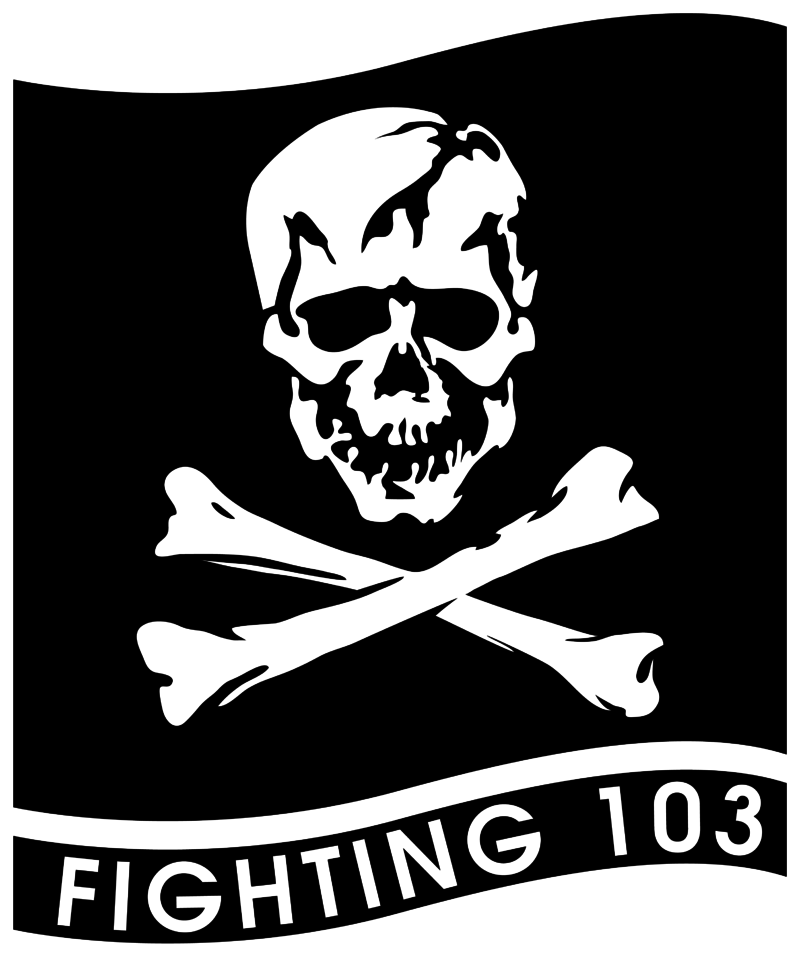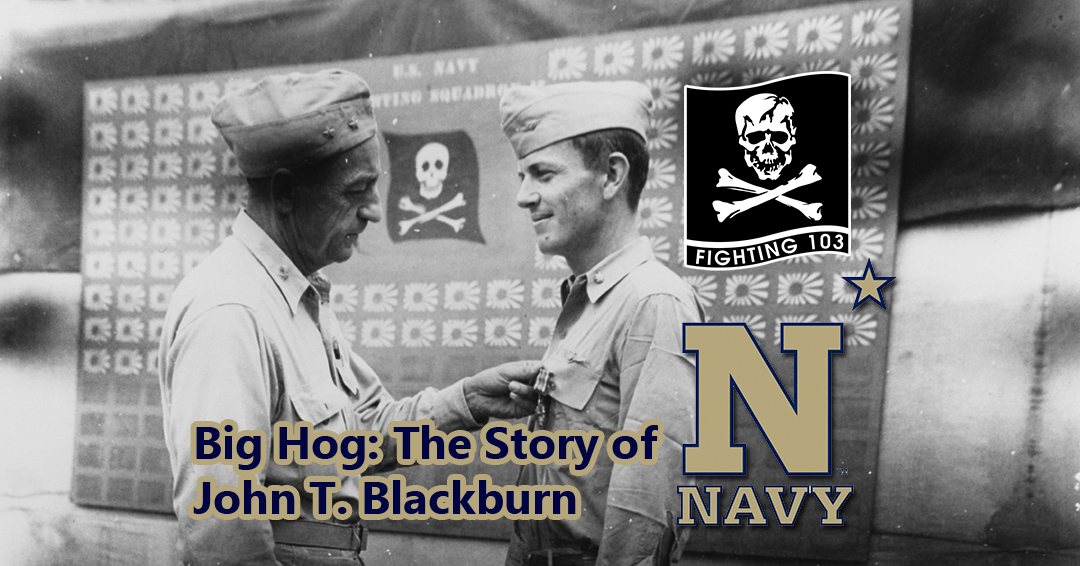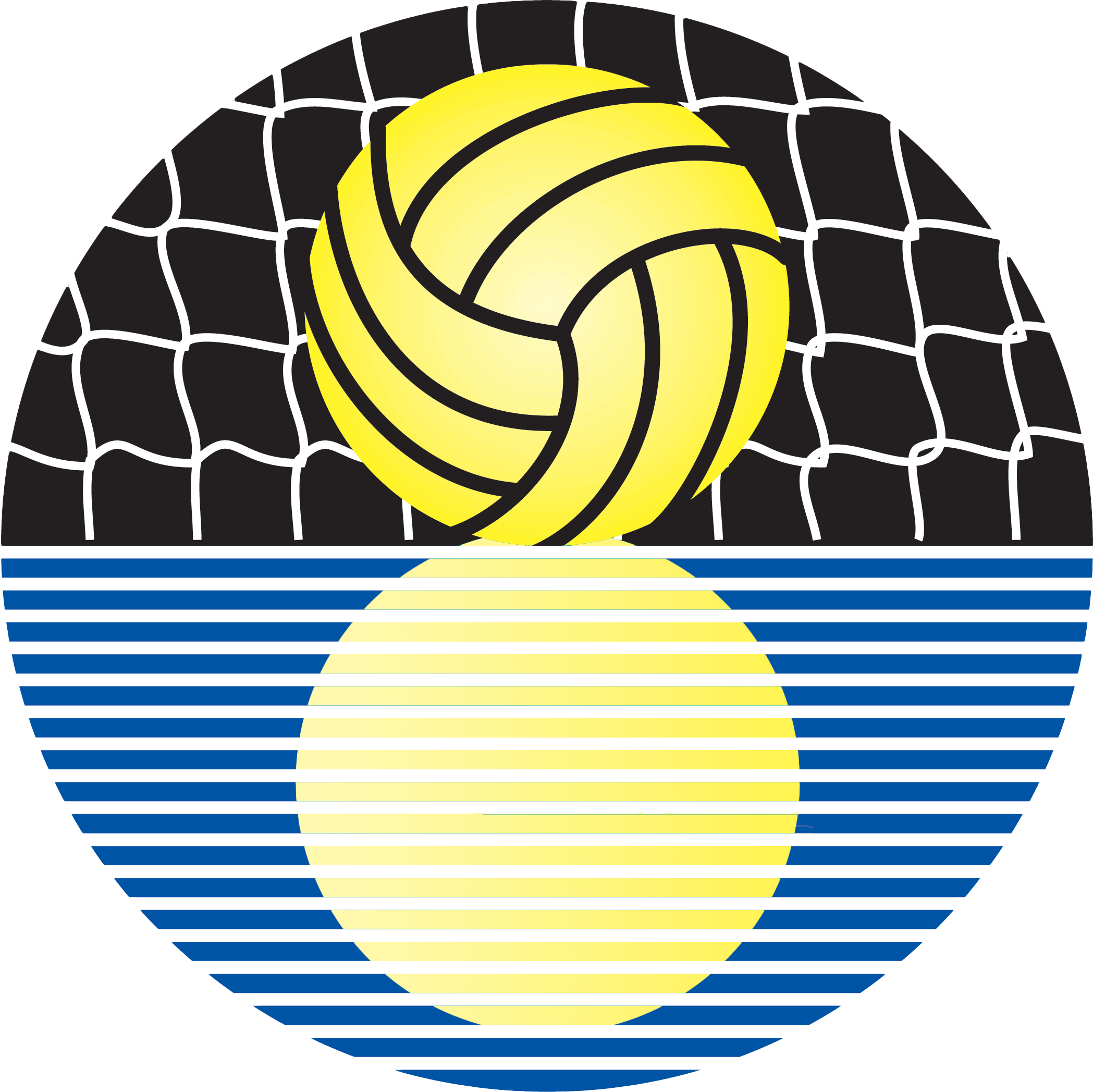BRIDGEPORT, Pa. — On November 20, the United States Naval Academy announced the institution’s uniforms for the 2024/125th playing of the Army-Navy Game presented by USAA (United Services Automobile Association) at Northwest Stadium in Landover, Md., will honor Navy squadron VF-17 “The Jolly Rogers”.
What many do not know is the squadron has a direct connection to the Navy water polo team via John Thomas “Tommy” Blackburn – an American naval aviator, World War II flying ace, United States Naval Academy graduate, Midshipmen water polo athlete and the first commanding officer of the famed F4U Corsair squadron VF-17 Jolly Rogers.
Born in Annapolis, Maryland, on January 24, 1912, and raised in Washington D.C., Blackburn graduated from Western High School and elected to continue his family into the Navy by first attending the Severn School in Severna Park, Md. His father was a 1904 graduate of the Naval Academy, while his brother Paul P. Blacburn graduated from Annapolis in 1930. Further, an uncle, Lieutenant Commander C.K. Blackburn was a 1916 graduate of the Academy.
He entered the Naval Academy by Presidential appointment on June 17, 1929, and participated in both soccer and water polo during his days as a Midshipmen. A 1933 graduate of the Naval Academy, he was commissioned an Ensign.
He was assigned to the USS Mississippi, in which he served first as a junior Watch and. Division Officer, and from June 1935 to February 1936 as Aviation Observer. In March 1936 he reported to the Naval Air Station, Pensacola, Florida, where he completed flight training and was designated Naval Aviator on February 26, 1937, prior to his detachment in April of that year. During the next year he was assigned to Bombing Squadron 5 of Fleet Air Detachment, Naval Air Station, San Diego, California later redesignated Bombing Squadron 2, and based on the USS Lexington. In June 1939 he was transferred to Fighting Squadron 2, also based on the Lexington, and served. as a fighter pilot, with collateral duty in Engineering, until February 1941. In March 1941 he reported to the Opa Locka Naval Air Station near Miami. Florida, and was serving as a fighter plan instructor in the Brewster F2A Buffalo when the United States entered World War II in December of that year.
After several requests for a combat assignment, he received orders in July 1942 to organize VGF-29 as commanding officer and report aboard the new escort carrier USS Santee. VGF-29 was equipped with the Grumman F4F-4 Wildcat. Blackburn assembled a ready room of mainly brand new ensigns fresh from winning their wings at advanced flying school at Naval Air Station Corpus Christi. Luckily he had the assistance of a combat veteran from the recent Battle of the Coral Sea, Lt.(jg) Harry “Brink” Bass who received the Navy Cross for his attack on the Japanese aircraft carrier Shōhō.
Blackburn set up operations at a remote field at Pungo well away from the brass and traffic at NAS Norfolk and was soon promoted to Lieutenant Commander. Pungo suited Blackburn fine as he wanted an undisturbed environment to get the squadron acquainted with the Wildcat and ready for deployment and the combat likely to follow.
The squadron embarked aboard USS Santee in October 1942 to participate in Operation Torch, the Allied invasion of North Africa. Arriving in the waters off Morocco on November 6, VGF-29 flew first combat mission on 8 November but could not find their target, and poor weather and damaged homing equipment aboard Santee forced them to ditch or force-land their Wildcats. Blackburn floated adrift in a liferaft for three days before he was spotted by a destroyer and rescued.
Shortly thereafter in December 1942, fate set him on a different path as he fitted out Fighting Squadron 17 in Norfolk, Virginia, and served as Commanding Officer from its commissioning, on January 1,1943, until May 1944, the squadron based on the USS Bunker Hill during part of that time.
VF-17, flying the F4U Corsair, earned the nickname of “Jolly Rogers” as Blackburn inspired by the fact that the Corsair name was derived from the French Privateers (pirates), selected a skull and crossbones as VF-17’s insignia.
All the aircraft were repainted with ominous all-black tails and black bands with gold chevrons painted on the side of the forward fuselage.
Harry Hollmeyer, as squadron pilot conceived the original design, which was painted on the cowling of the Corsairs that were also known as “hogs.”
Blackburn named his Corsair “Big Hog” and together with his executive officer, Roger Hedrick embarked on an intensive training program to get his squadron ready for the planned deployment to the Pacific in August 1943, and the combat that lay ahead. Again, he chose a remote field well away from Norfolk to operate as he saw fit and away from prying eyes of the senior leadership.
The squadron deployed aboard USS Bunker Hill and worked hard to adapt the F4U Corsair to the carrier environment, which necessitated some design changes, resulting in the F4U-1A model.
The Jolly Rogers deployed to the Pacific, but upon arrival there the Navy decided to initially land base its Corsairs. The squadron flew to Guadalcanal on October 26 where it received orders to begin operating out of Ondongo (which means “Place of Death”) on the island of New Georgia in the Solomon Islands. They arrived on the 27th, just in time to participate in providing air cover for the Landings at Cape Torokina, near Empress Augusta Bay on Bougainville Island on November 1; this drew attention from the considerable Japanese presence at their bastion of Rabaul. Blackburn and his Jolly Rogers were assigned the high cover mission for the landings and ran into a wave of Japanese Aichi D3A “Val” dive bombers escorted by Mitsubishi A6M Zero fighters. Blackburn downed two and the squadron three more in their combat debut.
On November 8, 1943, The Jolly Rogers faced their biggest test to date when six Jolly Rogers faced an attack of 15 Japanese D3A “Val” dive bombers escorted by 24 A6M “Zeros”. Hedrick launched with a flight of eight Corsairs, but lost two when they aborted. In the engagement, VF-17 downed three fighters and damaged four others with no losses. In its two tours of duty in the Solomon Islands, VF-17 had 152 aerial victories and produced 11 aces. Blackburn ranked third with 11 victories to rate as a double-ace behind Hedrick with 12 and Ira Kepford who led the squadron with 17. VF-17 finished its last combat tour in the Solomons on May 10, 1944 and many pilots were reassigned.
Cdr Blackburn led VF-17 (January 1943 – May 1944) to become the greatest fighter squadron with confirmed 154 enemy kills (an 8:1 loss ratio) plus 75 probable kills. They sank five transport ships and barges. No plane they escorted was ever shot down. In 76 days of combat they flew 8,577 combat hours and produced 13 flying aces. Forty years later, his pilots publicly credited the squadron’s skipper for its success; he taught them much and was successful in getting equipment and supplies they needed.
For outstanding service in that command, he was awarded the Distinguished Flying Cross and a Gold Star in lieu of the second Distinguished Flying Cross, later replaced by the Navy Cross.
The citations follow, in part:Distinguished Flying Cross: “For heroism and extraordinary achievement while participating in aerial flight as Squadron Commander of U.S. Navy Fighting Squadron 17, in action against enemy Japanese forces in the Solomon Islands Area from October 27 to December 1, 1943. Braving fierce enemy anti-aircraft fire and fighter opposition, Commander (then Lieutenant Commander) courageously and skillfully led his squadron on numerous hazardous missions pressing home effective attacks against Japanese shipping and airfields and, during three bitter engagements with hostile fighters.at Empress Bay, Bougainville, personally shot down four of the enemy craft and damaged five others..,”Navy Cross: “For extraordinary heroism as Commanding Officer of Fighting Squadron 17 during action against enemy Japanese forces in the vicinity of New Britain, Solomon Islands, from January 26 to February 26, 1944. Engaging in continuous operations throughout this period, (he) led his squadron in numerous successful escort missions and fighter sweeps over the enemy-held stronghold of Rabaul. Intercepted by an outnumbering force of hostile aircraft on January 26 and 30, he courageously closed with the enemy planes and personally blasted three from the sky and probably destroyed three others. In a subsequent engagement with a numerically superior force of Japanese aircraft on February 6, (he) struck furiously at the oncoming hostile planes, personally shooting down four and severely damaging two others. Sighting an enemy auxiliary schooner off Pondo Point on February 9, he led. his flight in a series of daring strafing runs to sink the hostile vessel…”He was awarded the Air Medal and two Gold Stars in lieu of additional awards for meritorious achievement in aerial flight in the Solomon Islands area, the first from October 29 to November 21, 1943, during which period he completed five missions; the second on November 8, 1943, when he destroyed an enemy plane in a raid on Buka; and the third on November 11, 1943, when he provided cover for aircraft carriers at night and destroyed an enemy plane. He is also entitled to the Ribbons for, and facsimiles of, the Presidential Unit Citation awarded the USS Santee and the Navy Unit Commendation awarded Fighting Squadron 17.”
Returning to the United States in March 1944, he had brief temporary duty in June 1944 in the Naval Air Operational Training Command, Naval Air Station Jacksonville, Florida, and on June 15, reported to the Navy Department, Washington D. C., for duty as Head of the Fighter Requirements Section, Military Requirements Division, Bureau of Aeronautics. During that period he was an Observer of the Second Battle of the Philippine Sea, October 22-26, 1944. He was detached in April 1945 and a month later became CAG (Commander, Air Group) of Carrier Air Group 74 (CVBG-74) aboard the newly commissioned aircraft carrier USS Midway. He served in that command for 15 months before returning to the Navy Department in September 1946.
After a year’s duty in the Office of the Chief of Naval Operations, assigned to the Office of the, Special Assistant to the Deputy Chief of Naval Operations (Air), he served from October 1947 to October 1949 in the Bureau of Aeronautics (Fighter Design Branch). He then joined the USS Saipan as Executive Officer, serving in that capacity until May 1951. From June of that year until July of the next, he commanded Composite Squadron 5, after which he was a student at the Naval War College, Newport’ Rhode Island, where he completed the Strategy and Tactics course in June 1953. He was next assigned to the Joint Strategic Plans Group, Joint Chief of Staff,, in Washington, D. C. , and, (under orders of March 18, 1955) served as Commander Heavy Attack Wing ONE, based at the Naval Auxiliary Air Base, Sanford, Florida. On May 31, 1957, he was ordered to the Bureau of Naval Personnel, Navy Department thence to the Naval Air Training Command, Naval Air Station, Pensacola, Florida, for temporary duty. In September 1957 he joined the Staff of Commander Naval Air Force, Pacific.
The commanding officer of the USS Midway from 1958-to-1959, Blackburn is also remembered as an early jet pilot in the Navy. He flew a Bell YP-59A Aircomet at Naval Air Test Center, Patuxent, on May 13, 1946 to become the 120th American naval aviator qualified to fly a jet airplane.
While commanding HATWING-1, Captain Blackburn participated in a demonstration of carrier mobility. On September 3,1956, he and his wingman each flew a Douglas A3D Skywarrior from the USS Shangri-La, off the coast of Oregon, across a finish line at the National Air Show in Oklahoma City, and on to Jacksonville, Florida, without refueling.
He retired from the Navy in 1962 as a captain and began growing wine grapes and raising “blue ribbon” Golden Retrievers in St. Helena, California.
After selling his St Helena, California, vineyard, Blackburn lived in Jacksonville, Florida and died there on March 21, 1994. He was buried at Arlington National Cemetery.
A replica of his F4U Corsair, with the Jolly Roger insignia and “Big Hog” written on the vertical stabilizer and the number one on the fuselage, was installed at the Washington Navy Yard in 1985 in honor of his service and The Jolly Rogers.
The squadron is also memorialized in the animated movies Planes as a fictional version of the squadron, the “Jolly Wrenches”, use the same livery, but the crossbones are replaced by wrenches.





